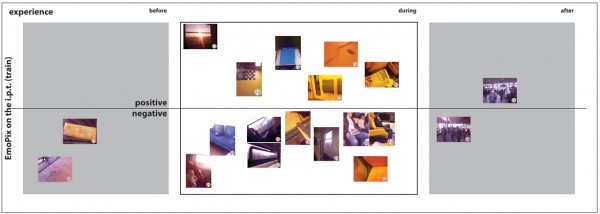Blog
Context mapping (part 1): Observation
EmoPix (Susa group ®)
Thanks to a graduation project called “Developing a Tool to Assess Emotions Elicited by Services” by David Güiza Caicedo (TUDelft 2009) was possible used a handheld with an EmoPix (Güiza Caicedo, 2009) tool to ask three participants about their impressions and emotions related to public buses in The Netherlands.
By using a handheld device with a built-in camera, a user can take pictures of different places, situations or things and add an emotional tag to them via a button (either physical or display based) depicting one of the available emotions. This way, the user can identify the stimuli by simply taking a photograph of them. In the end of the journey, the device was collected and the pictures were used to generate different sorts of visual collages, such as clustering them by location or by emotion, or building an emotional storyboard of the user’s experience throughout the time of his trip.
Three people were asked to use the hand held device to report on the emotions they felt while making use of the current train and bus systems. The photographs were then edited to include the depiction of the selected emotion on the lower right corner. These results were located on a graphic illustrating the three phases of the experience; before, during and after; in two different levels, positive experiences and negative experiences, each of these experiences have green and red background respectively.
The three positive emotions related with the experience are: fascination, joy, satisfaction and desire; and the negatives are: boredom, sadness, dissatisfaction and disgust. The experience is positive if the passenger (user) enjoys the journey and if it is not pleasant for them is negative. The collage provides information about emotions and places – objects and its relationships.
The exercise of taking a photograph and attaching an emotion to it was considered by the participants to be a clever and fun way to show how you feel throughout the journey, but they sometimes felt the need to explain themselves once they had taken a picture, as they were unsure whether or not it would be understood why they felt this, or towards which specific part of the picture. One respondent mentioned that sometimes he wondered if it was at all possible to capture what he wanted to show with a single static picture and suggested that from time to time he would have preferred to capture movement too.
Related posts:
- Context mapping (part 2): Personas
- Context mapping (part 3): Mobility Diary
- Context mapping (part 4): timeline
Javier Ricardo Mejia Sarmiento





